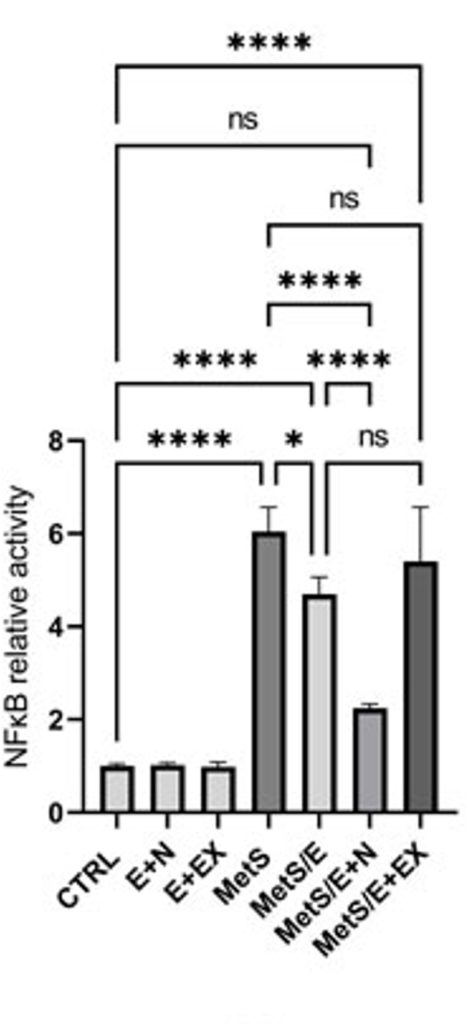NMN Enhances Sirtuin Activator Against “Silent Killer” of Aging, New Study Shows
NMN (nicotinamide mononucleotide) enhances the effect of longevity-associated sirtuin enzymes against metabolic syndrome in rats.
Highlights
- The sirtuin activator E1231 alone and combined with NMN improve the survival of rats with metabolic syndrome.
- E1231 alone and combined with NMN also prevents liver inflammation and scarring, reduces blood pressure and kidney damage, and improves insulin signaling.
- NMN enhances the effect of E1231 in reducing weight gain, liver damage, blood glucose, cholesterol, and fat levels, while elevating antioxidants.
Metabolic syndrome can be thought of as a sort of “pre-aging,” whereby underlying aging drivers, such as inflammation, promote a host of age-accelerating conditions, including central obesity, high blood pressure, and poor insulin sensitivity. It can also be thought of as “hidden aging,” because symptoms can go unnoticed. This is why metabolic syndrome is sometimes called the silent killer, increasing the risk of heart disease, stroke, and type 2 diabetes.
Now, researchers have found that the sirtuin activator, E1231, mitigates metabolic syndrome pathology in rats. Moreover, the NAD+ precursor NMN was found to enhance many of E1231’s effects against metabolic syndrome. These findings support emerging evidence pointing to combinatorial aging interventions being superior to single aging interventions.
Sirtuin Activation and NMN Prolong Survival
To model metabolic syndrome, the researchers fed lab rats a high-fat diet. This is because metabolic stress, like elevated blood fatty acids, promotes the chronic inflammation that sets the basis for metabolic syndrome. With this in mind, to exacerbate metabolic stress, the researchers also injected the rats with an antibiotic (streptozotocin) that damages insulin-secreting cells. This technique reduces insulin secretion, elevating blood glucose and fatty acid levels and exacerbating metabolic stress.

Feeding rodents a high-fat diet also reduces the activity of sirtuins, longevity-associated enzymes that are low in obese patients but increase with weight loss. According to previous studies, activating sirtuins, which are master regulators of cellular stress and metabolism, holds promise in counteracting metabolic syndrome. To test this, researchers fed the metabolic syndrome (MetS) rats a sirtuin activator named E1231 (E). Remarkably, the MetS rats fed E survived longer than the untreated MetS rats, at least over the 12-week experiment.

Since the NAD+ precursor NMN is known to stabilize sirtuins and sirtuins use NAD+ as fuel, the researchers fed a group of rats both E1231 and NMN (E + N). Additionally, another group of rats was fed both E1231 and the sirtuin blocker EX527 (E + EX). This latter group was used to confirm that sirtuin enzymes are indeed what prompt the beneficial effects of the sirtuin activator. The results showed that, when combined with NMN, the sirtuin activator conferred similar results on survival rates as E1231 alone. Additionally, blocking sirtuin enzymes abolished the effects of E1231, confirming that E1231 is prolonging survival by activating sirtuins.
NMN Enhances the Effect of Sirtuin Activation
Comprehensively assessing the effect of the E1231 sirtuin activator and NMN on metabolic syndrome, the researchers measured markers of metabolic, liver, and kidney health. As with the survival rates, in some cases, E1231 alone and E1231 combined with NMN had similar beneficial effects, including:
- Preventing liver inflammation and scarring
- Reducing systolic blood pressure
- Improving insulin sensitivity
- Improving kidney health
Moreover, NMN enhanced the effect of E1231 in:
- Reducing weight gain
- Reducing blood markers for liver damage
- Elevating native cellular antioxidant levels in the liver
- Reducing blood fatty acid levels
- Reducing blood LDL cholesterol levels
- Reducing blood glucose levels
To measure blood glucose levels, the researcher employed the Oral Glucose Tolerance Test (OGTT), which is used to diagnose diabetes. For this test, after an initial blood glucose reading, the rats were given a large amount of glucose. Subsequently, blood glucose was measured every 30 minutes for two hours. The results showed that while E1231 significantly reduced blood glucose levels, NMN enhanced this effect, bringing glucose levels down to normal.

NMN Enhances Sirtuin Activity
Sirtuins, specifically SIRT1, are enzymes that, by cleaving an NAD+ molecule, remove a group of atoms called an acetyl group from key proteins, including transcription factors — proteins that turn genes on or off. One of these transcription factors, NF𝜅B, turns on pro-inflammatory genes, which promotes chronic inflammation, an underlying biological driver of aging that predicts all-cause, cardiovascular, and cancer-related mortality.
The researchers showed that feeding MetS rats E1231 significantly reduced NF𝜅B activity and the level of key inflammatory proteins. Moreover, NMN was shown to more than double the efficacy of E1231 in reducing NF𝜅B. NMN also enhanced the reduction in inflammatory proteins, suggesting it enhances the inflammation-suppressing effects of sirtuin activation. Importantly, NMN was shown to enhance sirtuin activity, confirming that it enhances the primary effect of E1231 in activating sirtuins.

Combining Sirtuin Activators and NAD+ Precursors to Battle Aging
Sirtuins need NAD+ to function as master regulators of gene transcription. This study shows that combining a sirtuin activator like E1231 with an NAD+ precursor like NMN can enhance sirtuin activity more than either alone. At least one study suggests this is feasible in humans, showing that the NAD+ precursor NR (nicotinamide riboside) combined with the sirtuin activator pterostilbene reduces liver inflammation in adults with non-alcoholic fatty liver disease (NAFLD). Based on these studies, it would seem that combining sirtuin activators with NAD+ precursors could contribute to mitigating inflammation-based age-related conditions, including metabolic syndrome, NAFLD, cardiovascular disease, and cognitive decline.
Model: Sprague Dawley rats exposed to streptozotocin to induce diabetes
Dosage: 40 mg/kg/day of E1231 sirtuin activator and/or 250 mg/kg/day of NMN

